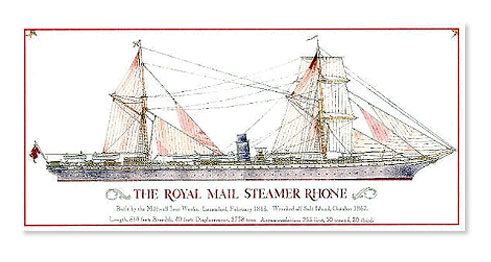Diving and learning fascinating history in the BVI


DAY 3 — I’m trying.
I’m about 60 feet underwater swimming past a giant propeller that sunk here in a hurricane nearly 150 years ago– Oct 29, 1867. That huge propeller could drive the 310-foott boat at a top speed of 14 knots.
Today the ship—the Royal Mail Steamer Rhone—is likely the top dive site among the British Virgin Island’s more than 100, and there are plenty of divers here when we arrive with Sail Caribbean, which not only offers excellent SCUBA diving instructions and experiences, but also runs great teen sailing camps. My daughter Reggie and her boyfriend Dan Foldes have just become certified divers, thanks to an online course from PADI and two days of instruction here with Sail Caribbean.
Today we are all diving as a family. The Wreck of the Rhone is just off Salt Island in two big pieces 60 to 80 feet down, but there are many smaller pieces.
My husband Andy was fascinated going through the bow. “But my favorite thing was hearing the history from Melisande Rowe, our dive master,” he said. “She told a great story about all the wrong decisions they made for what they thought were the right reasons.”
The Rhone—the premier mailship of her day–was actually supposed to go to the much busier port of St. Thomas that trip but because of an outbreak of Yellow Fever there, the passengers and cargo came to Tortola to take on coal and provisions.
On that fateful fall morning, the Rhone was under the command of Capt Robert Wooley. It was sunny and still but when the barometer began to fall (no sophisticated weather equipment in those days!) Wooley figured a storm was coming and hailed the captain from the nearby Conway. They shifted all the passengers to the Rhone, thinking they’d be safer on Peter Island.
As the hurricane blew in, Captain Wooley was the first casualty—washed overboard as he tried to assess the weather.
The passengers didn’t have a chance. They were strapped to their bunks.
The crew tried frantically to get the 300 pound anchor up and get the ship out to sea, but the anchor and chains were stuck. It was all over in a matter of seconds. No one knows what ultimately caused the explosion that sunk the ship. Either the Rhone hit a rock or a wave hit the ship, but the red-hot boiler furnaces blew the ship in half.
Somewhere between 7 and 20 passengers managed to survive—one washing up on the island of St. John 17 miles away. Because the people on Salt Island (so named because they harvested salt) worked so hard to save the survivors and bury the dead, Queen Victoria gave them the island—a wonderful gift for the poor islanders.
Some 200 perished on the Rhone in a hurricane in which 75 other vessels were either lost or seriously damaged.
Today, the Rhone is a constant source of fascination for divers and snorkelers—part of the ship can be snorkeled. We were actually able to swim through part of the wreck—it took us less than two minutes.
Dan Foldes was fascinated by the sea life that makes the Rhone Home—including a moray eel.
My daughter Mel loved the “lucky porthole” –number 26 that is still amazingly intact—divers are supposed to rub it three times for good luck. There is still a spoon with the captain’s initials.
There’s the gear box house and rudder, crow’s nest and mast, the hatch– all covered with coral and sponges. The Rhone is now a national park but our dive instructor, Melisande Rowe, said sadly that hasn’t stopped people from trying to steal the lucky porthole.
The massive size of the ship’s superstructure is amazing—as is the sea life that now calls it home–Queen Angel fish, fire coral, sponges that cover the wheel. Wow!
But the best part is sharing the adventure with my kids and husband.

